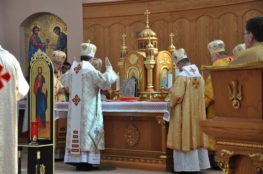Note: Although I plan to continue posting primarily on the theme of integralism, there are several sketches sitting in my “Draft” folder — most dealing with liturgy and history — that I want to complete and post as well. This is one of them.
Some time ago I issued a post entitled “A Note on Latinizations,” which, not surprisingly, was met with a mixed reception. In the year since it was written I have had some time to rethink the matter in the light of both ritual integrity and the fraught history of the Greek Catholic Church in Galicia. A particularly illuminating article on these (and other) matters is John-Paul Himka’s “The Greek Catholic Church and Nation-Building in Galicia, 1772-1918,” 8 Harvard Ukrainian Studies 426 (1984). In it, Himka explores the singular role the Ukrainian Greek Catholic Church (UGCC) played in creating a Galician (and by extension Ukrainian) national identity, one which owed more than a small debt to the so-called Josephine Enlightenment in Austria. Without opening the door too widely on that complicated period in European history, Himka offers a brief but informative analysis of how national and ritual identity clashed during the 19th Century for “Greek Catholic[s] [who] had an Orthodox face, Roman Catholic citizenship and . . . an enlightened Austrian soul” (pg. 438).
The reason for this clash is fairly straightforward since “[i]n the affairs of the spirit and liturgy [Greek Catholics] were obliged to look either east or west, since Greek Catholicism itself never had a chance to flourish as an independent religious tradition” (at least until the late 19th/early 20th Century) (id.). And thus began a series of conflicts over the question of “Russophilism,” that is the tendency of some Greek Catholic clergy to look to the extant praxis of the Russian Orthodox Church for spiritual and liturgical inspiration. Had these matters not been bound up with ethno-nationalist conflicts, perhaps they could have been sorted out in a more conciliar fashion, as the Ukrainian Metropolitan Hryhorri Iakhymovych desired. While Himka notes that “Russophilism” never fully died out, the fact that it met with wide disapproval among both the Austrian authorities and many Ukrainian Catholic leaders meant that it never gained a strong foothold during the tumultuous decades of the late mid-to-late 19th Century. Moreover, rabid Russian antipathy toward the “Uniate” Greek Catholic Church contributed to the cooling of “Russophilism” as well.
None of this meant that “Russophilism,” at least at the ritual level, was dead and gone, as Himka observes in this interesting footnote (pg. 438, n. 42):
One of the curious side effects of the [Ukrainian] youth ferment of the 1960s was the reappearance of a Russophile trend in Ukrainian Catholic seminarians in North America. Rebellious seminarians visited Russian Orthodox churches and monasteries, coveted Russian Orthodox liturgical and prayer books, dreamed of wearing Russian-style vestments, kolpaks and long beards and tried to boycott such papish accretions as rosaries and devotions to the Sacred Heart.
This is not the whole story of course. Prior to the unlawful suppression of the UGCC in 1946, efforts were already underway to de-Latinize the Slavo-Byzantine Rite used by Greek Catholics, culminating in the production of the Ruthenian Recension of Church Slavonic liturgical books published under the auspices of the Congregation for Eastern Churches in Rome. (The entire run of Ruthenian liturgical books has been made available again by Eastern Christian Publications.) The unfortunate irony of this project is that by the time it was finished, many Greek Catholic churches were already phasing out the use of Slavonic in their liturgies. Today few Ukrainian parishes in the West rely on their patrimonial liturgical tongue, preferring either contemporary Ukrainian or other vernacular translations. Whether such a move was either wise or prudent is itself a sticky matter—one I won’t delve into here. Needless to say, not everyone has been pleased with the transition, particularly the Ukrainian-based Priestly Society of St. Josaphat which champions both the use of Church Slavonic and, interestingly enough, Latin-based para-liturgical practices.
At this juncture it is probably impolite, and too polemically charged, to speak of “Russophilism” when examining the question of ritual purity (or, perhaps better phrased, ritualistic authenticity) among Greek Catholics. At the same time it hardly does a lick of good for those who embrace a de-Latinized Byzantine Rite to disparage either the classical liturgical heritage of the Roman Church or the decision of their forebears to take up Latin practices which are no less valuable than Byzantine ones. As I iterated in my earlier post on this topic, the days of Latinization among the Greek Catholics are by and large over. There’s no reason to mourn that fact, though that hardly means it should be a cause for triumphalistic celebration either.



